Inspired by Frank Miller’s ‘Sin City’ graphic novel, Emlyn Davies takes audiences on a hard and fast ride, charting the spectrum of lusts – blood, money, drugs, and alcohol – while poking fun at self-righteous hypocrisy.
For Emlyn Davies, founder of Bomper Studio, the opportunity to direct a music video for the new Foo Fighters’ song “No Son of Mine” came in a one sentence email. “After working with RCA on Tyler Childers Country Squire, the record company contacted us via a simple email with the subject: ‘Foo Fighters,’ and the body text ‘Call me I have a fun one for you…,’” he shares.
Based on a track from the group’s latest album, Medicine at Midnight, the CG animated music video No Son of Mine incorporates a live recording of the song as well as footage of the band performing it live. Taking cues from the song's lyrics and theme, the short follows a character through a night of wild debauchery and violence - from strip clubs to bar fights to high-speed driving - before a full punchline reveal of the character's true identity. Davies and co-director Josh Hicks worked to develop a visceral tale that was hard and fast, charting the spectrum of lusts: blood, money, drugs, and alcohol.
Take a moment to check out No Son of Mine:
Moving forward after that first brief email, Davies “had an initial conversation with RCA” and was told that they were looking for an animated music video reminiscent of the fast-paced vibe in Smack My Bitch Up by The Prodigy. “Lyrically, the song is meant to poke at the hypocrisy of self-righteous leaders, and they wanted a story that fit this overall theme,” he notes.
“Along with this flipbook approach to the debauchery, we were given live-action footage from Jimmy Kimmel Live of the band’s live performance and were asked if we could use it for the music video,” Davies explains. “There was an additional test piece where Dave Grohl had recorded himself with an app where the effect made him look like he was in the movie Sin City. All of this formed the basis of us looking at how we could tackle the animation, with a very tight turnaround, and gave us some food for thought on our visual approach.”
Being huge fans of the hard-boiled storytelling and gritty aesthetics from comic book noir, such as the work of the iconic Frank Miller, Bomper worked to design the music video in similar fashion with tools like Cinema 4D, ZBrush, EBSynth, Adobe Premiere Pro, Adobe After Effects, and Adobe Photoshop.
According to Davies, “First thing we did was get a treatment together to pitch our idea of the story, style, and approach for the overall animation. We worked to develop a story which follows a character through a night of wild debauchery and violence.”
After reviewing the work of Miller and other comic book noir artists, and assessing their given production schedule, Davies knew “we could only feasibly do between a minute to a minute and a half of CG character animation at 12fps,” so he looked at treating the live-action footage to match the animation style.
“At this point, I’d stumbled upon the work of Thomas Shahan and loved the style of a bust he’d created in 3D which had a striking, contoured woodcut texture which looked almost inky,” he says. “With this and some other reference, along with a storyboard created by co-director Josh Hicks, we talked the record label through our approach, and they and the band really liked it!”
As production began, the first hurdle was creating minimal, instantly readable environments. “This stylistic approach not only worked well for the stark and contrasted aesthetic, but lent itself well to the deadline, as asset creation didn't require as much detail as a full-scale, elaborately textured 3D production,” Davies reveals.
“To keep the film feeling like a cohesive whole, we edited the live-action footage and treated it by hand-painting frames from each shot and then running them through EBSynth to match the grungy, stark, duotone output of the CG shots,” he continues.
The Bomper team used Ftrack for work review, which Davies found “really helpful” because of both the pandemic and working in different time zones. “The band and the label were amazing and would run with any ideas we had,” he says. “We did have to remove some overly explicit scenes, which was fine, as we managed to tone them down where needed, but on the whole the reviewing was very quick with minimal issues.”
Noting the extremely short production schedule, Davies says, “In total, we had three weeks production on it. The team was amazing. Everyone was excited to work on it to pull it together. Part of the reason we pushed the comic book noir visuals was that unlike realistic renders, we were able to hide a lot more and focus on the action instead of the technicalities of rendering. In total, we had about 16 people working on it in various departments.”
“Lots of things fell into place, like reaching out to Thomas to help create the character textures, plus the work on the AI to play with the live-action,” he adds. “It's amazing to see where artificial intelligence will be taking the future of animation, and whether that's good or bad!”
“The biggest challenge had to be the schedule,” he continues. “It’s amazing to see what an agile team and tight deadline brings out as we’re extremely happy with the results. The other challenge was trying to add a dynamic feel to almost static shots in the live-action. That was difficult, but the team pulled it off.”
Despite the creative and schedule challenges, Davies is pleased with the final film. “I think we capture exactly what Dave Grohl had envisaged for the song,” he concludes. “It was an open brief, so we feel the style and overall narrative hit all of the aspects required. Nothing is overly smooth or slick, but it works to serve up a shot of pure adrenaline straight to the heart.”
Dan Sarto is Publisher and Editor-in-Chief of Animation World Network.














